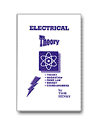|
To learn electricity, the invisible
force that became the major means of making man the master of
the earth, you must first learn the methods of producing and
controlling it and learn the rules or laws that apply to the
behavior of electricity.
All the effects take place in
a tiny particle called the electron. Since you can't see an electron,
the Electrical Theory book will
be very helpful as it will show, in motion it's behavior, called
electron theory.
Electricity is produced by very
tiny particles called electrons and protons.
These electrons and protons are
too small to see, but they exist in all matter.
Matter is defined as anything
that has weight and takes up space. It can be in the form of
a solid, liquid or gas.
First, we must know something
about the atomic structure of matter.
|

| The Electrical
Theory book covers the atom, valence shell, magnetism and
more. Includes Exams and answers. |
|
|
Atoms are the basic materials
that make up all matter. Everything we see is made from atoms.
There are over 100 atoms such as oxygen, hydrogen, nitrogen,
aluminum, copper, silver, gold, mercury, lead, sodium and chlorine
to name a few.
There are many more materials
than atoms. Atoms can be combined to produced materials. An example
is water which is a compound made from hydrogen and oxygen. Although
hydrogen and oxygen are both gases that when combined (H2O) can
produce water; a liquid.Through the activity of the electrons,
atoms combine to form a molecule of material.
The molecule is the smallest
particle that a compound can be reduced to before it breaks down
into its atoms.
An example is salt which is produced
by the two atoms chlorine and sodium. If a grain of salt was
broken in half and that half was broken in half and you continued
to break it in half until it could be recognized as salt, we
would have a molecule of salt. If we broke it in half again we
would have reduced it back to its two atoms of chlorine and sodium.
The smallest particle that an
element can be reduced to and still keep the properties of that
element is called an atom.
Atom is the Greek word for indivisible
(not able to be divided).